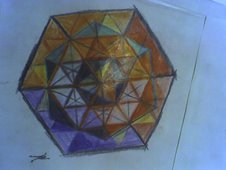Let there be three points: A, B, C on plane P.
Is the triangle formed by segments AB BC CA the smallest shape possible that intersects these points?
Wouldn't a circle intersecting these three points be the largest shape possible?
No, because you could have a polygon with N sides, only two of which need to to pickup points A, B and C. Bastards!
Is a circle really a polygon with infinite edges? Pilar says it depends on whether a segment can be one point in length.
I don't think it can. I think that is prohibited by the whole thing about a line being shortest distance between two points. Bastards!
But what if the two points are immediately adjacent to one another?
I mean, sure, there are infinite points on any line segment, but each one must have a next-door neighbor.
So couldn't a circle just be a polygon with infinite edges formed by immediately adjacent points?
On the sub-nanoscopic scale, each portion of a circle might look something like this:
0-----0
---0---
The main difference, of course, is that this slight difference in angle would be very, very, very tiny. I have exaggerated the angle it by many powers!
Every point on every circle mirrors the angle of both of its neighbors' OTHER next door neighbor. This is another way of saying that they share the same slope, I suppose.
We will return to this fascinating subject tomorrow.
For homework, please write in your blogs what today's inquiry means to your interior life. In your relationships, are there angles of incidence and reflection? In your cosmos, can you predict the movement of other beings by plotting their angles of right ascension and declination?
Ptolemy dedicated his work to studying "those things that always remain what they are"; to what do you dedicate your attention?
skip to main |
skip to sidebar



